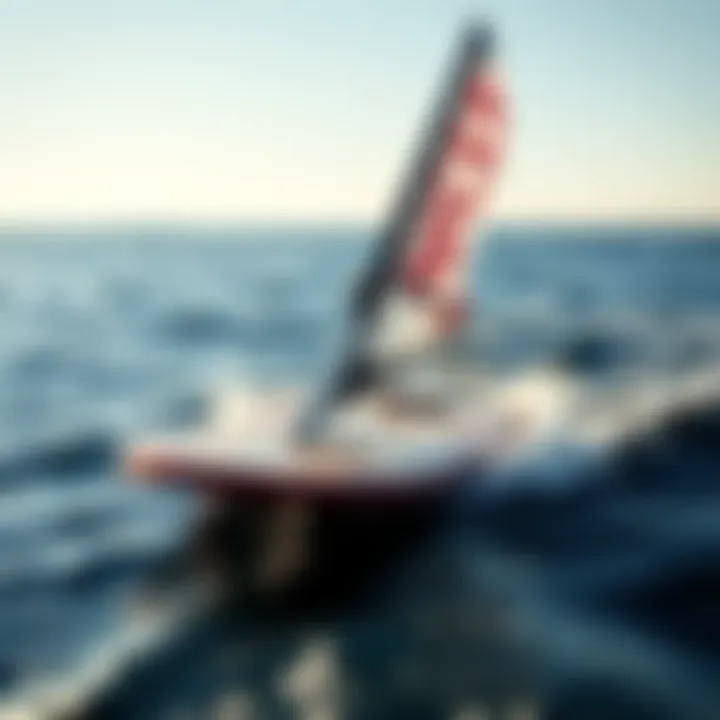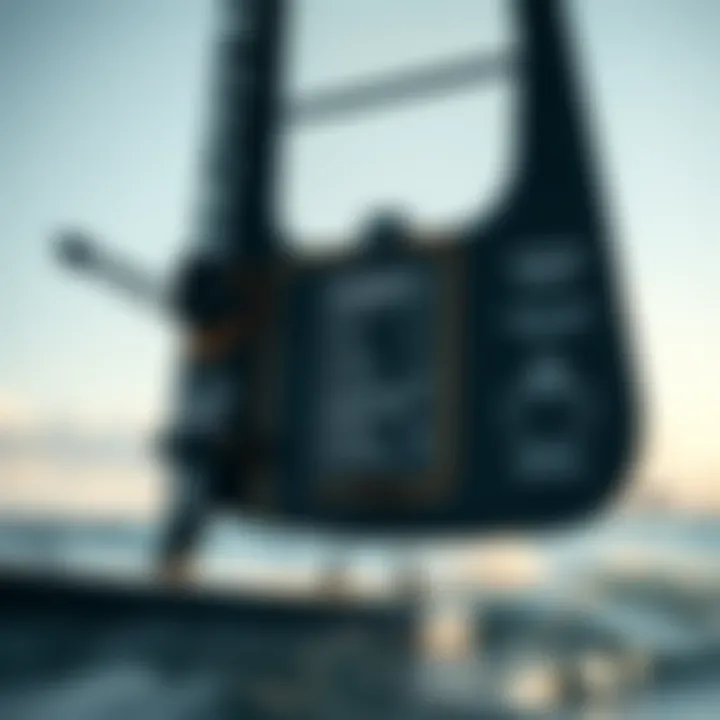Exploring Hydrofoil Sail Boards: Design and Experience


Intro
The world of surfing has undergone significant transformations, especially with the advent of hydrofoil sail boards. These innovative watercraft have attracted the attention of surfers and adventurers alike, blending technology with the age-old thrill of riding waves. Designed to provide a unique riding experience, hydrofoil sail boards elevate the surfer above the water's surface, drastically changing how they interact with waves and currents.
In this article, we will explore the intricate design and functionality of hydrofoil sail boards. We will dive into the unique technology behind them, the techniques necessary for mastering these boards, and the experiences shared by those who dare to ride them. Not only do we want to inform, but we also aim to inspire a deeper connection with this exciting aspect of surfboarding culture.
Understanding hydrofoil technology is critical for both novice and seasoned surfers. It shifts the focus to physics and dynamics, ultimately offering a different perspective on rideability in various water conditions. The benefits of hydrofoil surfing aren’t just confined to performance enhancements; they also promote sustainability and accessibility to new surfing environments—we are witnessing a blend of nature and innovation like never before. Let's embark on this journey and see what awaits in the realm of hydrofoil surfing.
Prelims to Hydrofoil Sail Boards
The sport of surfing is not just about riding waves; it’s about harnessing technology to amplify our connection with the ocean. Hydrofoil sail boards stand as a testament to this evolution, blending traditional surf culture with cutting-edge engineering to grant riders unparalleled experiences. In this section, we’ll dive into the essence of hydrofoil sail boards, exploring their significance, foundational technology, and the waves they’ve begun to ride within the surfing community.
Defining Hydrofoil Technology
Hydrofoil technology revolves around the unique design of underwater wings, which lift the board above the water’s surface as speed increases. This principle of lift reduces drag — the resistance that slows down movement — making it simpler for the rider to glide over waves. Riders experience a sensation reminiscent of flying, allowing them to enjoy smoother rides and an increase in speed. Essentially, hydrofoils transform the way surfers interact with the elements, transitioning them from merely skimming the surface to soaring high above it.
When we talk about hydrofoil boards, it’s essential to grasp how they differ from standard surfboards. Regular boards rely on buoyancy to stay afloat and experience the waves while hydrofoil boards depend on their wing structures hidden beneath the water. This shift in dynamics opens up a realm of possibilities, especially in diverse conditions where traditional surfing might fall short.
Origins and Evolution of Hydrofoil Boards
Historically, the idea of using a foil-like structure to manipulate watercraft goes back several centuries, with initial concepts emerging in the early 1900s. Alexander Graham Bell, known for his advancements in telecommunications, dabbled in hydrofoil design in 1919, creating what many consider the precursor to today's hydrofoil boards.
Over the decades, this technology matured and found its way into various forms, from racing yachts to sea planes. The significant innovation came when surfers and windsurfers began adapting hydrofoil designs to create boards that could elevate a rider above the water. This spiraled into the modern hydrofoil sail board, which has come to be revered for its sleek design and performance capabilities.
As we move through the timeline of these watercraft, it's clear that the fusion of necessity, innovation, and engineering has resulted in a groundbreaking shift in how surfers engage with water sports, paving the way for the future of surfing.
Through understanding their design, functionality, and the exhilarating ride they offer, one can fully appreciate the unique adventure that hydrofoil sail boards bring to the table.
Design Elements of Hydrofoil Sail Boards
The design of hydrofoil sail boards plays a pivotal role in how they operate and the experience they offer. These elements are not merely aesthetic; they directly impact performance, stability, and the joy of sailing on the water. Understanding the materials, wing designs, and shapes involved in hydrofoil construction reveals how they contribute to the sport’s advancement. Each design choice is a blend of functionality and innovation, geared towards improving the sailor's experience.
Materials Used in Construction
The materials selected for hydrofoil sail boards are crucial for achieving the right balance between weight, strength, and buoyancy. Most modern hydrofoils are crafted from composite materials like carbon fiber and fiberglass, which provide a lightweight frame while maintaining durability. High-density foams are often infused as cores within the wings and boards, further enhancing buoyancy, which is essential for lifting off the water surface.
- Carbon Fiber: Known for its high strength-to-weight ratio, carbon fiber is utilized in the construction of the hydrofoil's structure. This material helps in keeping the board light while ensuring it can withstand the roughness of the sea.
- Fiberglass: Another common material, fiberglass offers flexibility and resilience. It's often used in entry-level boards, providing a solid alternative with slightly added weight but benefiting from lower production costs.
- Alloys: While not as common, metal alloys may be used for specific components, such as the mast or fuselage, where extra strength is needed without excessive weight.
Each material's choice hinges on the desired performance characteristics the surfer seeks, weighing factors like speed and ease of handling in different water conditions.
Wing Design and Performance
The wing design is integral to how hydrofoil sail boards generate lift and maintain stability. This component is the unsung hero of hydrofoil performance. The wings' shape can significantly affect the board’s efficiency at various speeds and sea conditions. For instance, wings with a larger surface area are better at generating lift at lower speeds, which is beneficial for novice riders looking to learn the ropes. On the contrary, smaller wings enable greater maneuverability and higher speeds, appealing to advanced users.
- Aspect Ratio: A high aspect ratio wing, resembling a long and narrow shape, reduces drag and increases lift at speed, favorable for cutting smoothly over water.
- Camber: Adding curvature to the wing enhances lift by changing airflow beneath it, which can be tailored to specific riding styles and conditions.
- Profiles: The wing profile, whether elliptical, swept, or straight, can deeply influence performance metrics like speed and stability. Surfers often have their preferences based on their riding style and intended use.
These options enable surfers to fine-tune their gear according to conditions they expect to encounter, making wing design a key aspect in both performance and skill development.
Board Shapes and Sizes


Choosing the right board shape and size is like tailoring a suit; it needs to fit the rider's style and body. With hydrofoil boards, the dimensions can influence balance and handling. Generally, boards come in varying lengths, widths, and shapes, designed for diverse conditions and surfing experiences.
- Length: Longer boards typically offer more stability and allow for smoother rides, especially in choppy waters. They are suited to beginner surfers or those looking for comfort while learning.
- Width: The width of the board affects how much surface area is in contact with the water, influencing balance. A wider board may provide greater stability, while a narrower board allows for sharper turns and speed.
- Rocker: The curvature of the board from nose to tail, known as rocker, can affect how easily the board transitions from one state to another. A pronounced rocker helps with maneuverability and navigating waves, while a flatter design may enhance speed and control.
Functional Mechanics of Hydrofoil Boards
Understanding the functional mechanics of hydrofoil boards is crucial for any surfer looking to elevate their experience. This section delves into the intricate elements that dictate how hydrofoil boards perform on the water, providing a solid foundation for those who wish to embrace this modern surfing method. The synergy between design and functionality is what makes hydrofoil surfing not just an activity, but an art form in itself.
How Hydrofoils Generate Lift
At the core of hydrofoil technology is the principle of lift, which is generated as the board moves through the water. Hydrofoils work similarly to an airplane wing. As the hydrofoil moves forward, water flows over and under the wings, creating a difference in pressure. The shape and angle of the wing are pivotal in this process.
- Angle of Attack: This term refers to the angle between the wing and the oncoming water. A slight increase of this angle can significantly boost lift. However, if this angle exceeds a certain threshold, it can cause the board to stall, losing lift abruptly.
- Hydrodynamic Shape: The wing shape of the hydrofoil is designed to optimize water flow. A larger surface area allows for more lift, but it can also increase drag. It’s a delicate balance that every surfer must understand for maximum performance.
- Speed Factor: The faster one goes, the more lift one generates—up to a point. Surfers often find that a speed range exists where the hydrofoil operates most effectively, allowing them to glide over the water without much input.
In short, grasping the concept of how hydrofoils generate lift can considerably enhance a surfer's enjoyment and proficiency while riding the waves.
Stability and Control Factors
Stability and control are essential considerations when operating a hydrofoil board. Unlike conventional surfboards, hydrofoils ride a few feet above the water, which can make balancing a bit tricky.
- Center of Gravity: Riders must maintain an ideal center of gravity for stability. Leaning too far forward or backward can result in a loss of control, leading to a potentially harsh fall. Many surfers find that keeping their knees slightly bent and weight distributed evenly helps keep them upright.
- Board Size and Shape: Different board sizes can greatly influence stability. A wider board typically provides more surface area, which can make balance easier for beginners. However, seasoned surfers might prefer a narrower board for quicker maneuvers.
- Wing Design: The design of the wing also impacts stability. Wings that are longer tend to offer a more stable ride in choppy waters, while shorter ones can give sharper turns but might sacrifice steadiness.
"Navigating a hydrofoil board is like dancing with the elements; understanding stability and maneuverability helps you find your rhythm."
The interplay of these factors ultimately determines how well a surfer can control their ride, guiding their experience on the open water. To sum up, mastering the functional mechanics of hydrofoil boards not only enhances one’s performance but can transform an ordinary surfing session into an extraordinary adventure.
For further reading on the principles behind hydrofoils, check out informative resources at Britannica or learn more about surfing techniques on Reddit.
Engaging with the mechanics at play will bring a new layer of appreciation and skill to any surfer willing to dive into the world of hydrofoil sailing.
Advantages of Hydrofoil Surfing
Hydrofoil surfing is not just another passing craze in the ever-evolving world of aquatic sports. It's emerging as a significant advancement that redefines how enthusiasts experience the water. The advantages offered are substantial, making hydrofoil boards a worthwhile investment for anyone looking to enhance their surfing experience. Here, we dive into the most compelling benefits of this innovative surfing method, focusing on speed, efficiency, and versatility.
Enhanced Speed and Agility
One of the most striking benefits of hydrofoil boards is the enhanced speed they can achieve compared to traditional surfing. This isn't just about going fast; it’s about feeling the rush of gliding above the water with minimal resistance. The design of the hydrofoil allows it to lift off the surface, creating a unique aerial experience that gives riders a different sense of control.
The lift generated by the hydrofoil enables surfers to catch waves more efficiently, often requiring less power from the wind. Surfers who have switched to hydrofoil boards often express a feeling of being almost weightless. This effect creates an exhilarating sensation that experienced surfers crave.
Moreover, with this increase in speed comes greater agility. The ability to maneuver quickly through the water allows for sharp turns and dynamic surfing styles that were previously challenging to achieve with a standard board. This agility is particularly appealing for those who enjoy exploring tricky waves, as it provides opportunities to ride waves that may have been deemed too dangerous before.
Reduced Drag and Energy Efficiency
Hydrofoil boards are designed specifically to minimize drag. When you ride on the foil, the entire board is elevated above the water surface, which dramatically reduces the friction that typically slows you down. Surfers often find that they can go for longer distances with less effort, thanks to this significant reduction in drag.
In practical terms, this means that hydrofoil surfing demands less physical energy from its riders. Imagine being able to paddle out further into the surf with less strain on your muscles. This energy efficiency not only leads to longer sessions on the water but also preserves the rider’s stamina, allowing for more runs on the waves. Coupled with the improved speed, this aspect makes hydrofoil boards appealing to both seasoned surfers and novices who may find traditional surfing physically taxing.
The economics of energy consumption is another element to note. Surfers on hydrofoil boards often report lowering their overall energy expenditure, enabling them to enjoy extended periods on the water without feeling completely worn out.


Ability to Ride in Varied Conditions
Hydrofoil boards shine in a variety of water conditions that might deter traditional surfboards. Whether it’s choppy waters, light winds, or even smaller swells, hydrofoil surfing offers versatility that is hard to match.
This adaptability is a game changer for surfers looking to maximize their time on the water. Riders can venture into conditions they might previously have avoided, turning what could be a mediocre day of surfing into an unforgettable experience. Folks who frequent coastlines where wave conditions are fickle find hydrofoils invaluable, as they can still catch a thrill when the waves are not cooperating.
In addition to diverse surf conditions, hydrofoil boards can be used for various water sports such as kiteboarding and stand-up paddleboarding. The fusion of styles enhances the overall surfing culture and encourages more individuals to engage with the water creatively. The freedom to explore different methods of hydrofoil usage makes it a fantastic option for adventurous surfers.
Skills Required for Hydrofoil Sailing
Understanding the skills needed for hydrofoil sailing is no small potatoes. Unlike traditional surfing, where balance and paddling are the bread and butter of your ride, hydrofoil sailing demands a different playbook. This section explores the nuances of balance, positioning, and the critical moments of takeoff and landing.
Hydrofoil boards operate by lifting above the water, which opens a new realm of excitement balanced with the demand for skill. When you're above the surface, the mechanics change—creating an exhilarating experience, but one that requires focused attention and practice. Grasping the fundamentals of balance and positioning can make the difference between a breathtaking ride and a harsh tumble.
Fundamentals of Balance and Positioning
Attempting to ride a hydrofoil without proper balance is like trying to walk a tightrope in a windstorm. Your body has to be in sync with the board to harness its capabilities effectively.
- Center of Gravity: In hydrofoil sailing, positioning your center of gravity is the secret sauce. You need to keep your weight centered over the board while shifting slightly forward or backward based on speed and water conditions.
- Leg Strength and Stance: Your legs are the unsung heroes. A strong, athletic stance will help you absorb the inevitable bumps and movements of the board. With knees slightly bent and feet firmly planted, you're better prepared to handle the dynamics of the ride.
- Upper Body Engagement: Don't neglect your upper body. Keep your arms loose but engaged as they help guide your movements. Your shoulders and hips should work in tandem to assist in directing the board. This engagement can greatly enhance your balance on the water.
By blending these elements, you cultivate a solid foundation that opens the door to more advanced techniques and helps you feel at home on the board.
Mastering Takeoff and Landing
Takeoff and landing—every graceful ballet has its two critical moments. These are especially heightened in hydrofoil sailing, where the lift-off can feel like a magic trick when executed correctly. But—don't kid yourself—getting them right is often where many beginner sailors falter.
- Timing and Speed: A successful takeoff relies heavily on timing and speed. As you start to gain momentum, you'll want to lean forward gently to initiate lift. The right timing can elevate you above water and transition seamlessly to gliding. Too much or too little speed could send you crashing down.
- Controlled Descent: Landing is just as crucial. As you prepare to descend, it’s important to gradually shift your weight back while maintaining your balance. Think of it like riding a bicycle downhill; if you lean too far back too soon, you risk losing control. A steady hand and well-timed lean will help you land softly.
In summation, mastering these takeoff and landing techniques requires practice and patience. Embracing each challenge will not only improve your skills but also boost your confidence on the water.
"Balance is not just about trees in yoga; it’s about finding your groove on a hydrofoil as well.”
Embracing the art of balance and control while learning to take off and land effectively is key to a successful journey in hydrofoil sailing. As with any art, practice not only makes perfect, but it brings forth a deep satisfaction in conquering each hurdle.
For further insights into hydrofoil sailing techniques and experiences, consider visiting resources such as Wikipedia, or engaging with the community on platforms like Reddit for shared experiences.
Maintenance and Care for Hydrofoil Boards
Taking care of a hydrofoil sail board isn’t just a chore; it's the difference between a short-lived piece of equipment and a reliable companion for many waves to come. Just like any vehicle, a hydrofoil board requires regular attention to keep it performing at its best. Proper maintenance ensures that your investment is safeguarded against wear and tear, ultimately extending its lifespan and optimizing your riding experience. Moreover, attending to the maintenance of these boards ties back to safety on the water. A well-maintained board responds better, allowing for more precise maneuvers in changing conditions.
Routine Inspection Guidelines
Regular inspection should be part of every hydrofoil rider's routine, almost like a pre-flight check for a pilot. Understanding each component of the board can help you notice small issues before they become major headaches.
- Check the Foil: The foil is arguably the heart of your board, so look for any dings or bends. Using a level surface, you can inspect the angle of the wing. If it’s not perfectly aligned, it could lead to unstable rides.
- Examine the Board Surface: Look for scratches, cracks, or any signs of water intrusion. Especially pay attention to the area where the foil connects to the board. These spots are prone to stress.
- Inspect Fittings and Mountings: Make sure that screws and mounts are tightened. Loose fittings can be a recipe for disaster. A simple twist might save you from a mishap.
- Harness Condition: The harness is what keeps you connected to the board. Check for fraying and integrity.
Taking time for this routine inspection enhances safety and prolongs the board’s functionality. Even for the casual surfer, taking care of these details adds to the joy of the sport.
Repairing Wear and Tear


Despite diligent care, bumps and scrapes are part of the game. Fixing these small injuries to your board is crucial for continued enjoyment. The repair process can seem daunting, but with a bit of elbow grease, even novice surfers can make their boards look new again.
- Minor Dings or Cracks: Use marine epoxy for small dings. Make sure the area is clean and dry before applying. Once it sets, sand it down to blend it with the rest of the board.
- Gel Coat Repairs: For deeper scratches or chips, you may need to use a gel coat. It helps in restoring that glossy finish and protects against water damage.
- Foil Maintenance: If your foil is bent or dinged, it might need realignment or replacement. For realignment, a professional can re-shape it, but minor dings can sometimes be fixed by carefully smoothing them with sandpaper.
- Proactive Measures: Beyond fixing existing damage, consider preventive measures. For instance, using a board bag not only keeps it safe while traveling but also reduces wear while riding.
With the proper care and maintenance, hydrofoil boards can capture the essence of riding the waves for a great many seasons.
"An ounce of prevention is worth a pound of cure."
Being vigilant in care might just elevate your experience, keeping you connected to the stoke of surfing and the thrill of flight above the water.
For more on the maintenance of aquatic gear, check resources such as Wikipedia or Britannica. Also, community insights can contribute to your knowledge, as shared on platforms like Reddit or Facebook groups.
The Future of Hydrofoil Surfing
The world of hydrofoil surfing stands on the brink of exciting evolution. As we look ahead, the potential for advancements in technology and community dynamics offers a fertile landscape for both newcomers and seasoned enthusiasts. Hydrofoil boards are moving beyond the realms of niche sport; they are emerging as a significant contender in the overall surfing culture. The importance of this future vision lies not just in what’s next, but in how these developments will reshape experiences on the water, encouraging wider participation and innovation.
Technological Innovations on the Horizon
Innovations are cropping up like daisies across the board (pun intended) as engineers and designers leverage fresh technologies to enhance hydrofoil surfing. Some upcoming developments include:
- Electric Assistance: Imagine gliding across the surface with minimal effort. Electric hydrofoil boards are becoming a reality, providing additional lift and speed. This technology could make hydrofoil surfing accessible to a broader audience, regardless of physical ability or skill level.
- Smart Sensors and Data Analytics: Future boards may incorporate sensors that track performance in real time, offering feedback on balance, speed, and riding conditions. Riders could manage their performance like it’s a video game; adapt and improve with each ride by analyzing their data post-session. This could also be used in coaching, creating a more robust learning experience for novices.
- Advanced Materials: The latest composites and lightweight materials are being researched to improve durability while reducing weight, making boards even more responsive. This is particularly significant for riders seeking speed and agility. Lightweight materials allow riders to feel more connected to the water.
These technological innovations aim to improve not just the riding experience but also the accessibility and safety of hydrofoil surfing.
Predicted Trends in Surfing Communities
As we gaze into the future, several trends are likely to shape the hydrofoil surfing community:
- Increased Popularity and Inclusivity: As the thrill of hydrofoil surfing continues to captivate more surfers, we might see an increase in community events dedicated to this sport. Competitions and festivals will likely become more common, celebrating hydrofoil talent and creativity while promoting inclusivity among various skill levels.
- Sustainability and Eco-Friendly Practices: The environmental consciousness of surf communities is growing. Expect to see a marked shift towards sustainable practices. Eco-friendly manufacturing materials and recycling initiatives will be at the forefront, as brands and riders work to minimize their impact on oceans and waterways.
- Collaborative Innovations: As manufacturers, athletes, and enthusiasts connect through social platforms, new ideas and designs will flourish. This collaboration is set to push the limits of what’s possible, leading to hybrid boards that blend elements of hydrofoil and traditional surfing, or boards specifically designed for different conditions.
"Innovation often stems from community dialogue, blending diverse insights into something unprecedented."
The future of hydrofoil surfing is not just about the advancement of technology; it’s about the growth of a community that evolves together, championing the experience on the water. The blending of creativity, sustainability, and a spirit of inclusivity will define the next chapters in this exhilarating journey of surfing.
Culmination
The conclusion of this exploration into hydrofoil sail boards carries significant weight, wrapping up a detailed study on a revolutionary aspect of the surfing universe. This article has brought to the forefront the blend of design, functionality, and the exhilarating experiences that hydrofoil boards offer to enthusiasts of all skill levels.
Recapitulating Key Insights
Throughout the previous sections, we have examined how hydrofoil technology elevates surfboarding to new heights—quite literally. The unique engineering of these boards, from the materials used to their aerodynamic designs, works in harmony to create a seamless ride over the water's surface. Some critical points included:
- Hydrofoils generate lift through strategic wing designs that optimize performance while minimizing drag.
- Surfers benefit from enhanced speeds by effortlessly gliding, which brings an incredible thrill that set these boards apart from traditional options.
- Maintenance is pivotal; keeping your hydrofoil board in top shape extends its lifespan and ensures consistent performance.
This article has distilled these insights into a user-friendly format. We positioned experienced riders and newcomers alike to appreciate and understand what makes hydrofoil surfing unique. Whether it's the high-octane rush or the feeling of floating just above the water, the key takeaways speak to a sport continuously on the rise.
Invitation to Experience Hydrofoil Surfing
If the prospect of hydrofoil surfing has piqued your interest, it’s high time to get your feet wet—quite literally. The world beyond the beach awaits, filled with energy and innovation that reshape how we perceive and interact with water sports. Visiting local surf shops or participating in training sessions offers an engaging step into this community.
For those brave enough to take the plunge, here are some options to consider:
- Test Rides: Many shops offer demo days or rentals. Get a feel for the board before committing to a purchase.
- Joining Local Clubs: Socializing with other surfers can provide invaluable tips and tricks. It creates a network where you can share experiences and learn together.
- Workshops and Lessons: If you’re serious about mastering the art of hydrofoil sailing, invest time in professional instruction that covers fundamentals to advanced maneuvers.
As seen through this discussion, the hydrofoil sail board is more than just a craft; it's a ticket to exhilaration on the waves. An invitation is extended to everyone curious—embrace the possibilities of hydrofoil surfing, an adventure awaits that’s bound to provide thrills and unforgettable memories.







